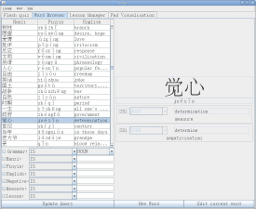Software
-
TrailgraphActive2007-present
Trailgraph is a hypertextual, partly-collaborative Computer Assisted Language Learning system and formed the basis of a lot of the work I did during PhD research. It should pervasively tracks user interaction with the system and uses that individual and group data to cluster similar learners by their behaviour. These cluster can then be used to automatically generate tutor-style recommendations of resources, and to alterations in an individual's learning styles. Focusing on (preferably immersed) beginning learners of Mandarin, it presents an electronic dictionary interface to the user for basic tasks, and a reflective interface that allows them to explore the network of associations formed between items as they and other users learn.
-
CookerActive2008-present

Visual programming language targeted at beginners. The visual approach was chosen to separate the semantic and syntactic learning phases of programming. Programs are built by adding blocks which represent expressions or statements inside each other. Syntax mistakes are not possible as only valid types of blocks will be accepted by the containing block. The language is intended to be very close to non-OO Java constructs and is easily expanded via block panels.
The program contains an interpreter for the programs which allows step-by-step execution, stack traces, variable watching, and aborting program execution. The editor supports zooming in and out of the program, collapsing individual functions, and printing. A pervasive tooltip system is combined with a dynamic help system to allow local instructors to trivially augment it with class material.
The file format is XML (compressed by default) which contains checksums to detect text corruption (eg, via email) and there is a tool to assist in plagiarism detection.
-
CLLECompleted2005-2006

Chinese/Classless Language Learning Environment. This was written as I was studying at Fudan University as a tool to help me learn. Contains a user-entered dictionary of words which allows quick, complex querying. It also has a flashcard drilling/quizing interface.
This formed the beginning of the Trailgraph project.
-
TaenarumAbandoned2003-2004
Taenarum was a distributed, collaborative, real-time programming development environment. It provided a Smalltalk-style code-browser to source code without having to have it in a particular format. It would read and parse standard source code as required so that it could be used by individual developers without having an effect on anyone else in the project (this is compared to most IDEs then, and now, which litter code with special files and file structures). Any edit actions that a user performed would be transmitted live to other Taenarum users on the same server so they could see a virtual "developing version" of the code as it happened. It had language plugins for C, Java, and Dylan, in various states of completion, CVS support, and a Java evaluation playground (via a third party interpreter).
Development slowed down as I got busy with other things and changed the way I worked. Collaborative editing was starting to be added to popular text editors which have better support than just me. Finally abandoned when I accidentally left the source code in the UK when moving to live in China.
-
MinervaSuspended2003-2004
Minerva was an attempt to take high-resolution satellite images, such as those provided by the USGS, and automatically regenerate a 3D environment from them. The idea was that this would rapidly accelerate the first stage of content creation in open-world sandbox games which were popular at the time. Since others had better knowledge of image processing than me (ie, any), I decided to explore different approaches to identifying objects in the images.
This eventually got bogged down for three reasons:
- An insistence on complete automation when minor user inputs could have solved significant problems. For example, the road extraction algorithm needed a start point. Large amounts of time went into automatically identifying that when a single click from the user would have sufficed.
- Frustration at being limited to only visible light images, since these were the only type freely available. Other wavelengths would have simplified tasks like foliage and water identification.
- Getting side-tracked by not only starting to build an OpenGL widget set, but trying to do so without using the traditional hierarchically structured approach.
Dylan and OpenGL
-
Visualisation of the Boehm-Demers-Weiser Conservative Garbage Collector (GCSpy integration to BDW GC)Complete2001-2002

Senior project at University of Glasgow. GCSpy is a generic garbage collection visualisation framework. This project integrated it into the BDW conservative GC. As this was the first conservative GC supported, some changed to GCspy were required. Overall, the project was a success. It was successfully integrated and collector behaviour could be easily observed.
Hand and machine written C, Java, assembly language, Dylan, inter-language binding definitions. [report][presentation]
-
Artemis debuggerComplete2001
A custom-written, C++ remote debugger for an in-house Domain Specific Language. Written in 3 weeks at the end of a work placement with BT, working on the new Emergency Services (999) call handler system. Has limited live code replacement ability. Previous debug ability was a 1-line text gadget showing the currently running line of code, or breakpointing inside the DSL interpreter itself. Project was just about to be moved from development to maintenance with an outsourced team. This debugger allowed them to debug problems at the business logic level, where almost all the bugs lay, rather than the C++ implementation code.